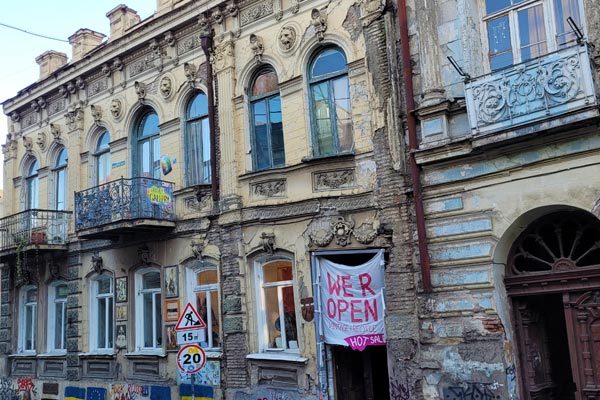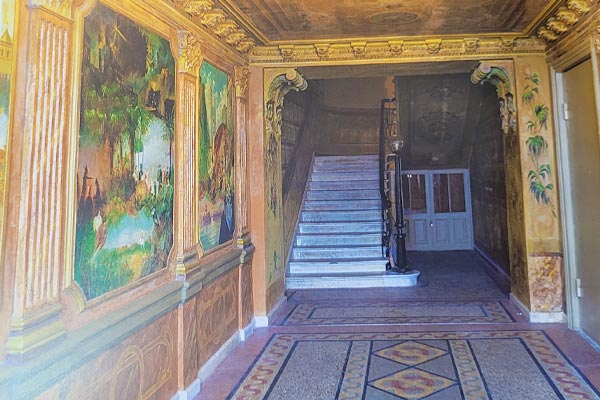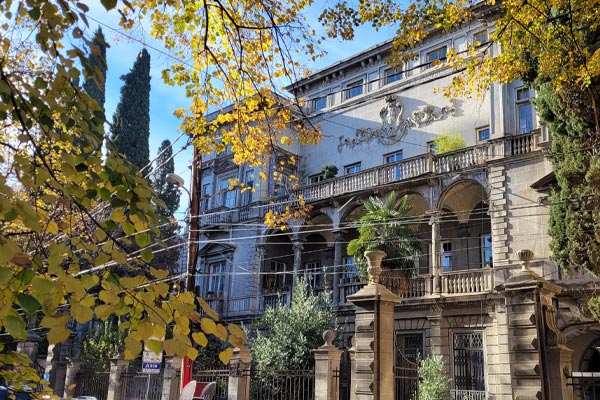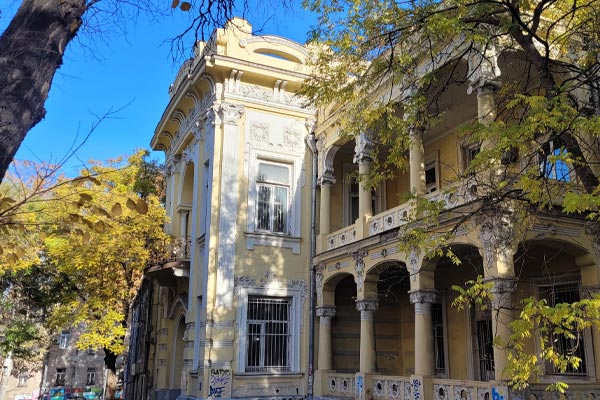|
Sololaki District Nestled behind Tbilisi's vibrant Freedom Square, the Sololaki district stands as a testament to the capital of Georgia's rich tapestry of culture, history, and, above all, awe-inspiring architecture. Once the esteemed abode of the world's wealthiest families, including the likes of Rothschild, Nobels, and Siemens, Sololaki beckons us to explore its captivating story. In this blog, we embark on a journey to unravel the secrets woven into the very fabric of Sololaki — from the intricacies of its architectural marvels and the captivating designs adorning its houses to the exquisite paintings and ornaments that grace its streets. Yet, beyond the superficial allure, we delve into the tumultuous history that renders Sololaki a fascinating mosaic of human narratives. Where exactly is Sololaki? The boundaries of this enchanting district are demarcated by G. Nizhnianidze, L. Asatiani, Amaghleba, Chonkadze, and Asatiani streets, forming a canvas upon which the stories of its past are painted. Why did Sololaki become the richest district in the city? The late 19th and early 20th centuries marked a renaissance for Tbilisi, a period intertwined with the first oil boom. As global businessmen sought fortunes in the oil fields of Azerbaijan, the inability to access the world's oceans through the Caspian Sea steered the likes of Nobels, Siemens, and Rothschild toward Tbilisi. In a fascinating turn of events, they even managed to outshine the renowned American oil baron, Rockefeller, in their Georgian endeavors — a saga deserving of its own spotlight. While affluent Europeans found a haven in Sololaki, a parallel narrative unfolded with wealthy Armenians establishing their businesses, spanning Georgia and parts of Tsarist Russia, from this dynamic district. The aristocracy and bourgeoisie, discerning in their choice of residence, gravitated toward the prestige of Sololaki, leaving the historic center of Tbilisi, in Kala or Avlabari, to those with more modest means. The dawn of a new era heralded fresh trends in architecture and interior design, yet Sololaki's story is not one bound by convention. Occasionally, the elite sought the extraordinary, resulting in murals adorned with biblical or historical motifs — some sprawling genre pieces, others immortalizing scenes from literature. Sololaki, a living testament to the confluence of prosperity and creativity, invites us to traverse its storied streets, where every building whisper tales of opulence, resilience, and the ever-evolving spirit of Tbilisi. What does Sololaki mean? Sololaki (translated from Arabic as 'canal' or 'aqueduct') was originally an area outside the old city walls. At that time, the Avanaantkhevi River ("khevi" is the Georgian word for "gorge") flowed through the beautiful gardens of the Bagrationi royal family and members of the aristocracy. The original name of the area comes from the numerous canals dug to irrigate the gardens. What used to be in Sololaki? Most of Sololaki lies on the southern slopes of the Sololaki Mountains, where the Bagrationi royal family and members of the Georgian aristocracy had beautiful gardens irrigated by the Avanaantkhevi River. In the 19th century, after Georgia was annexed by Russia and incorporated into the Tsarist Empire, the local aristocracy sold most of the land to foreign businessmen. Which streets are worth seeing in Sololaki? In Sololaki, every street and almost every house is impressive for different reasons, but in order not to make the blog too long, we decided to write about the most interesting corners of Sololaki from our point of view. 1. Leonidze Street This street has changed its name many times. From 1934 to 1990, it was named after the Soviet statesman Sergei Kirov. Since the 1990s, the street has been named after the famous Georgian poet Georgi Leonidze. As Sololaki Street was warmed by the sun all day long, people of Tbilisi also called it Warm Street. It is interesting to knw that the underground canal system and the Avanaantkhevi River were the main difficulties in the construction of today's Sololaki neighbourhood. These problems were successfully solved in the 1840s when the river was diverted into a brick culvert under the street. Sololaki developed into a residential neighbourhood, which is why urban buildings are rare in this area. The only exception is Leonidze Street. Interesting buildings in Leonidze Street
2. Sulkhan Saba Street Formerly “Fräuleinstraße”, today named after Prince Sulkhan-Saba Orbeliani, an outstanding Georgian writer, scientist, diplomat and tutor to the Georgian Crown Prince and later King Vakhtang VI. Interesting buildings in Sulkhan Saba Street There are several interesting buildings in this street, one of which is: House #. 3, where Ekaterina Svanidze, the first wife of the then Bolshevik underground fighter Joseph Stalin, who called himself Joseph Dzhugashvili, lived with her son Jacob in the 1890s. 3. Ingorovka Street The street was originally named after Peter the Great. After the establishment of the Soviet Union in Georgia, it bore the name of Leo Trotsky for several years until he was declared an "enemy of the state" and left the city. Until the early 1990s it was named after Felix Dzerzhinsky, the founder of the Cheka, the first Soviet secret police. Today the street is named after Pavle Ingorokva, a well-known Georgian literary critic. Interesting buildings in Ingorovka Street House # 3, located further along Pavle Ingorokva Street, has always been surrounded by mystical legends, as there is a special head sculpture above one of the façade windows. The head represents Pan, the Greek god Hermes, who in Greek mythology is usually depicted as a man with horns, a goatee and legs. House # 14, was the seat of the first British diplomatic mission in the South Caucasus from 1919 to 1921, headed by Sir Oliver Wardrop, British diplomat, traveller, translator and author of the book "The Kingdom of Georgia", published in 1888. Vukol Berdidze Street In the 19th century, the house of Prince Bebutov stood here, which is why the street was called Novobebotovskaya Street until the 20th century. During the Soviet era, the street was named after Mikha Tskhakaia, a prominent member of the Georgian Communist Party. Since 1990, the street has been named after Vukol Beridze, an important Georgian linguist and literary scholar. Interesting buildings in Beridze Street
Paolo Iashvili Street Originally named after General Rtishchevskaya, who signed a very important treaty between Tsarist Russia and the Persian Empire in 1813. The street was renamed after the well-known Bolshevik Aliosha Japaridze during the Soviet era. He was one of the 26 Baku commissars who were shot in 1913 after the fall of the Baku Commune. Like most streets in Sololaki, this street was renamed after Georgia gained independence. Paolo Iashvili - Symbolist poet and co-founder of the "Blue Horns" poets' association lived in this street, which was named after him. Interesting buildings in Paolo lashvili street
Chonkadze Street Most of the streets in Sololaki are named after important generals, officials or even members of the Tsar's family. This street was also named after the Russian count, general and field marshal Ivan Gudovich, who liberated Kocibey, today's Odessa, from the Turks. Today the street is named after Daniel Chonkadze, a Georgian writer and author of the famous novella "The Surarni Fortress". Interesting buildings in Chonkadze Street
The main staircase of the house appears to be built into the rock. In fact, it is a very interesting engineering solution; the staircase is covered with a clay tunnel, and in the upper part there is a courtyard and a garden in front of the house. Directly on the threshold is the inscription "SALVE". (Greetings!). Amaghleba (Ascension) Street The former Kodjori Street is closely associated with the Georgian writer, historian and publicist Platon Ioseliani. He vowed to build a church on Kodjori Street in the Sololaki neighbourhood when his son recovered from a serious illness. His son died, but he built the church, after which the entire neighbourhood was named in 1852. In 1921, the Bolsheviks who came to power destroyed the church and renamed the street after the labour poet Josef Davitashvili during the Soviet era. The street was renamed after Georgia's independence, a new Church of the Assumption was built on the same site and the street was given back its historical name. Interesting buildings in Amaghleba Street
In 1921, he founded the House of Armenian Art in Tbilisi and became president of the Armenian Relief Committee in the same year. Lado Asatiani Street No other street in Sololaki has changed its name as often as this one, and no other street in Sololaki has so many remarkable houses side by side, especially in Art Nouveau style, as Asatiani Street. Because of the many gardens in the area, Asatiani was called Garden Street (Sadovaya) at the beginning of the 19th century, later it was called Bebutovskaya Street after Prince Bebutov and Friedrich Engels Street in between. Today the street is named after the Georgian poet Lado Asatiani. Interesting buildings in Asatiani Street
The vocational school existed until 1922, after its closure the building became a public school.
Dadiani Street This street of Sololaki district has also changed its name several times. In Tsarist times, it was called Alexey Velyaminov. He was a lieutenant general and took part in the wars against Napoleon. After the establishment of Soviet rule in Georgia, the street was named after the Bolshevik Lado Dumbadze. It was him, who organised and carried out a terrorist attack in Rustaveli Avenue (previous Golovinsky Prospekt) in Tbilisi on 19 June 1920. The founder of the Democratic Republic of Azerbaijan, Fatali Khan Khoyski, was killed in the attack. For a while, the street was also called Chavchavadze, but was later renamed after the actor, novelist, playwright and translator Shalva Dadiani. Dadiani translated William Shakespeare, Friedrich Schiller, Lord Byron, Leonid Andreyev, Anton Chekhov and many others. Interesting buildings in Dadiani Street
The idea of the painting is allegorical: the female figures represent the Horae, the Greek goddesses of the seasons and the natural order of time: Thallo, the goddess of spring buds and green shoots; Auxesia, the goddess of spring growth; and Carpo, the goddess of the fruits of the earth.
Kikodze Street Originally named after the general and hero of the Battle of Borodino against Napoleon - Ivan Paskevich. He was one of the closest confidants of Russian Tsar Nicholas I. During the Soviet era, the street was called Philip Makharadze. A Soviet party and state leader. On 16 February 1921, as chairman of the Georgian Revolutionary Committee, he announced the founding of the Georgian Soviet Republic and asked the Russian Soviet government for military assistance. This was granted immediately and on 25 February 1921 troops of the 11th Red Army attacked and captured Tbilisi. A short time later, the entire country was incorporated into the Soviet Union territory. In the 1990s, this street, like many others in Sololaki was renamed. Geronti Kikodze was a Georgian writer, literary critic and translator who translated Stendhal's Red and Black, Tristan and Isolde and Prosper Mérimée's stories into Georgian. Interesting buildings in Kikodze Street
The owners' monogram in the form of the letters "AM" has been preserved on the façade. Because of the beautiful stone balcony and the front garden, the house is sometimes referred to as an "Italian villa". During the Soviet era, the house was called the "House of the Party Elite". Machabeli Street This street in the Sololaki district is named after the Georgian publicist and translator Ivan Machabeli. Machabeli studied at the University of St. Petersburg, in Hoppenheim (Germany) and at the Sorbonne. His translations of Shakespeare's tragedies Hamlet, Othello, Macbeth, Julius Caesar and Antony and Cleopatra have enriched the Georgian language. There are many buildings worth seeing on Machabeli Street, but here are just a few of them.
During the Soviet era, the building was the headquarters of the Central Committee of the Communist Party, where Lawrenti Beria, the former First Secretary of the Central Committee, also lived. Later, the Central Committee of the Komsomol (Communist Youth League) had its headquarters here. Today, the headquarters of the Georgian Olympic Committee are located here.
The house belonged to the industrialist and philanthropist David Sarajishvili. As the Sarajishvili company supplied the Russian tsar's court with high-quality brandies over a long period of time and conquered most of the Russian market, it was awarded the honourary title of "Purveyor to the Court of His Imperial Highness" in 1913. Emperor Nicholas II was received in this house during his visit to Tbilisi in 1914. The building has belonged to the Georgian Writers' Association since 1921. Paolo Iashvili shot himself with a pistol in this house during a critical meeting of the Georgian Writers' Union, which was dedicated to "political vigilance", after his friend and comrade, the poet Titsian, was arrested.
Tabidze Street Tabidze Street is the best restored and most visited street in Sololaki district. Tabidze Street has many bars, restaurants, hotels and is often referred to as the first suburb of Tbilisi.
The Smirnov House Museum displays the personal belongings and possessions of many famous Russian and Georgian personalities of the 19th and 20th centuries. Today, the building houses the Caucasus House, a centre for cultural initiatives.
Niko Nikoladze was the first Georgian to complete a doctorate at university in Zurich. He met Karl Marx, who asked Niko Nikoladze to represent the International Labour Association in the South Caucasus. Between 1867 and 1872, together with the engineer Palashkov, he built the first railway line in the South Caucasus, connecting Poti with Tbilisi.
The vestibule is completely painted. Allegorical depictions of the continents of Asia, Europe and Africa are painted in oil on the walls of the vestibule. Several romantic paintings have been preserved above the staircase. Freedom Square The architecture of the square is a mixture of historical and modern elements. The square is surrounded by neoclassical buildings that give it a touch of elegance and history. In the centre of the square stands the Freedom Column, an imposing monument symbolising Georgia's independence. The combination of ancient architecture and modern design elements makes Freedom Square a visual highlight. Cultural significance: In addition to its political history, the Platz der Freiheit also has great cultural significance. Surrounded by theatres, museums, restaurants and cafés, the square is a centre of artistic and cultural activities. Street artists, musicians and performers regularly enliven the square and create a lively atmosphere. The cultural diversity is reflected in the various events and festivals that take place on the square. Several Names Through Time In the annals of history, the expanse that now hosts Liberty Square was once relegated to the status of a "suburb," lying beyond the protective embrace of city walls. Not until 1828 did this area formally embrace the title of a square, christened in honor of the Russian General Paskevich. Given the General's additional distinction as the Count of Yerevan, the square also carried the moniker Paskevich-Yerevanky Square. The transformative tale of this locale continued in 1851 when the Caucasus welcomed its inaugural opera house, gracing the square with an alternative identity—Theatre Square. Following Georgia's liberation from Tsarist Russia in 1918, the square echoed the spirit of newfound independence as Freedom Square. However, the winds of change shifted swiftly after Soviet Russia annexed Georgia, leading to an era when the square bore the name Beria Square. In the aftermath of Beria's demise in 1953, Lenin Square emerged, adorned by the imposing Lenin monument at its heart. A lasting emblem of Soviet authority dominated the scene until Georgia's reclamation of independence in 1991, prompting the removal of Lenin's statue and the triumphant revival of Freedom Square. Since 2006, the square has been graced by the enduring presence of the St. George monument, symbolizing resilience and continuity. The City Hall, a venerable structure in its own right, currently serves as the esteemed abode of Tbilisi's National Assembly. Erected in the 1840s by the visionary architect Giovanni Scudieri, this edifice initially functioned as the town hall before assuming the mantle of Tbilisi's city hall. In a nod to the past, two Griffon sculptures stand proudly before the building, once sentinels of the Tamashev Caravanserai on Paskevich Erivansky Square, known today as Tavisupleba or Freedom Square. Remarkably, this architectural gem also harbored Tbilisi's inaugural opera house until the lamentable fire of 1874 reduced it to ashes. Across from the National Assembly, the once-majestic caravanserai building has vanished from the cityscape, leaving behind only the echoes of its bygone glory. Walking tour of Sololaki district Travel agency Enjoy Georgia also offers guided tour of the Sololaki district. More information about the tour can be found here. |






